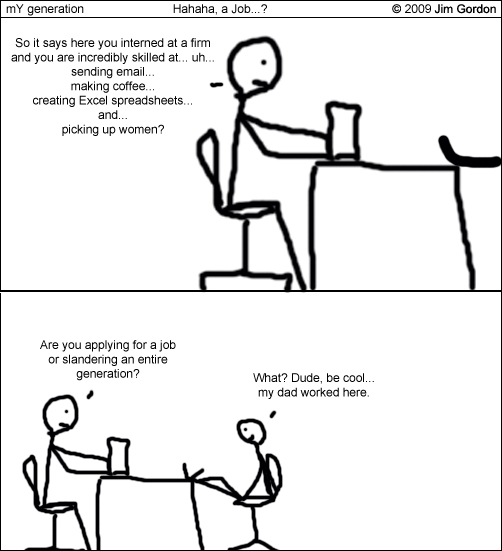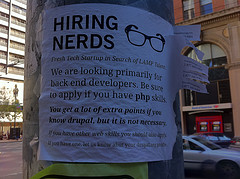|
|
|
Thursday, September 6th, 2012
 Tuesday I wrote that you should always consider the source of a comment before considering the comment itself. Tuesday I wrote that you should always consider the source of a comment before considering the comment itself.
The same day Serguei Beloussov, founder of Parallels and Runa Capital, said the same thing with regard to money sources in TechCrunch.
By viewing money as the most important thing for their business, startups often bring themselves into a corner. Entrepreneurs must place a premium on the quality of the investor(s) and understand why a smaller amount of money can serve companies better, in most cases, than big money with little or no relevant business expertise.
Sources also matter when it comes to the skills you need in your startup.
When a badly needed set of skills walks through the door managers and even team members will often turn a blind eye to the possessor of those skills.
The red flags that pop up during interviews are rationalized or ignored—even when they are waving madly in a high wind—a ‘get the skills and we’ll worry about the rest later’ attitude prevails.
The problem, of course, is that ‘later’ comes very quickly, often with weeks and sometimes just days.
At that point, you are faced with the choice of keeping the person and having your team damaged or even torn asunder or terminating her and starting your search over.
It doesn’t matter whether you’re evaluating comments or money or skills it’s the source that counts.
Or put another way (paraphrasing), it’s the people, stupid.
SUBMIT YOUR STORY
Be the Thursday feature – Entrepreneurs: [your company name]
Share the story of your startup today.
Send it along with your contact information and I’ll be in touch.
Questions? Email or call me at 360.335.8054 Pacific time.
Flickr image credit: Hartwig HKD
Posted in Entrepreneurs, Hiring | 1 Comment »
Friday, February 10th, 2012
A Friday series exploring Startups and the people who make them go. Read all If the Shoe Fits posts here
 Bosses hiring for startups (or existing companies) wax lyrical on the benefits of hiring “stars” and are willing to jump through almost any hoop to get one. Bosses hiring for startups (or existing companies) wax lyrical on the benefits of hiring “stars” and are willing to jump through almost any hoop to get one.
Those of you who crave stars would do well to read the story of Jeremy Lin, who plays for the NY Knicks in the NBA.
Nobody considered Lin a star or even a potential star.
He was cut in December by the Golden State Warriors, his hometown team, after one season in which he rarely left the bench. The Warriors were intrigued enough to sign him but not enough to keep him. The Houston Rockets gave Lin a quick look and cut him.
Of course, his coaches didn’t play him, so they never learned what he could do.
The Knicks almost made the same mistake.
Lin started with two strikes against him; he is Chinese-American and graduated from Harvard—he doesn’t fit “the profile.”
In spite of superb high school playing he received no scholarship offers.
Similar scenarios play out every day in hiring decisions across industries and around the country.
In doing so managers walk by some of the best talent available.
How many Jeremy Lins have you missed?
How many of them now work for your competition?
Option Sanity™ recognizes stars-to-be
Come visit Option Sanity for an easy-to-understand, simple-to-implement stock allocation process. So easy a CEO can do it.
Warning.
Do not attempt to use Option Sanity™ without a strong commitment to business planning, financial controls, honesty, ethics, and “doing the right thing.”
Use only as directed.
Users of Option Sanity may experience sudden increases in team cohesion and worker satisfaction. In cases where team productivity, retention and company success is greater than typical, expect media interest and invitations as keynote speaker.
Flickr image credit: HikingArtist
Posted in Entrepreneurs, Hiring, If the Shoe Fits | No Comments »
Tuesday, November 15th, 2011
 I write a lot abut the importance of culture and now and then someone calls or writes asking why I keep harping on it (BTW, I love when readers call, that’s why there’s a toll-free number in the right-hand column.) I write a lot abut the importance of culture and now and then someone calls or writes asking why I keep harping on it (BTW, I love when readers call, that’s why there’s a toll-free number in the right-hand column.)
I’m not the only one fixated on the role culture plays in everything from acquiring, motivating and retaining employees to creativity, innovation and overall company success.
- Booz’ strategy + business annual innovation survey focuses on culture, not money to improve results.
Booz & Company’s annual study shows that spending more on R&D won’t drive results. The most crucial factors are strategic alignment and a culture that supports innovation.
“My turnover was non-existent. Our turnover is only two percent. We also hire the right people almost every time, because we know that core values are more important than skills. We can teach the skills. Now that we’re all aligned for what the vision is and what’s important to us as humans, we have a culture of resilience and efficient productivity.”
- Lani Hay, founder/CEO of defense contracting company Lanmark Technology, turned over three COOs in the same year she won a prestigious national women’s entrepreneurship award and quadrupled company revenues.
“I don’t want to let anyone in the corporate culture who’s going to disrupt the culture and isn’t a good fit.” … Hay says she’s learned that she needs to listen to a wider array of Lanmark staffers, and make sure she values effective communications and an ability to work well with her team. She’s also paying more attention to cultural fit in hiring.
And for those looking to improve hiring there is no better screening tool than culture.
The biggest complaint I hear is that “culture stuff takes so much time” and I suppose that’s true when culture is applied like paint instead of stain.
Flickr image credit: zedbee
Posted in Culture, Ducks In A Row | 4 Comments »
Sunday, November 6th, 2011
Jim’s still on his honeymoon, so I’m still raiding the archives. See all mY generation posts here.

Posted in mY generation | No Comments »
Friday, November 4th, 2011
A Friday series exploring Startups and the people who make them go. Read all If the Shoe Fits posts here
 Yesterday I wrote abut new approaches to recruiting, a la online puzzles, to find tech talent from non-traditional sources, as well as advice from a successful entrepreneur who says that the most important traits to look for are behavioral and can only be identified through good interviewing, which requires time. Yesterday I wrote abut new approaches to recruiting, a la online puzzles, to find tech talent from non-traditional sources, as well as advice from a successful entrepreneur who says that the most important traits to look for are behavioral and can only be identified through good interviewing, which requires time.
All this says that younger entrepreneurs are willing to try radically new, as well as mastering old, approaches to finding talent.
The one thing I’ve found that many are not willing to do is hire outside their peers.
An old attitude that dates back decades (if not centuries) and which can be boiled down to five words—“people like me,” which defines your “comfort zone.”
It doesn’t matter that it’s illegal to say it involves age, but it does.
The bias is dangerous, especially when hiring more senior people as you grow. Consider these points,
- Can that brilliant developer you hired lead?
- Does the Twitter whiz kid understand creating and implementing a complete marketing strategy?
What exactly does a twenty-something a year or few out of school know about employment law, strategy, team-building, managing, conflict resolution, contract negotiation, the list goes on and on.
Whatever gave people the idea that creativity and innovation dropped off as experience increased?
One of these days in the not-too-distant future you are going to lose out on an opportunity because you are outside the company’s/manager’s comfort zone and the company is going to lose out on the richness of your experience.
How do you hire? What have you missed out on recently?
Option Sanity™ rewards performance.
Come visit Option Sanity for an easy-to-understand, simple-to-implement stock process. It’s so easy a CEO can do it.
Warning.
Do not attempt to use Option Sanity™ without a strong commitment to business planning, financial controls, honesty, ethics, and “doing the right thing.” Use only as directed.
Users of Option Sanity may experience sudden increases in team cohesion and worker satisfaction. In cases where team productivity, retention and company success is greater than typical, expect media interest and invitations as keynote speaker.
Image credit: kevinspencer
Posted in Entrepreneurs, Hiring, If the Shoe Fits | No Comments »
Thursday, November 3rd, 2011
 In 2007 Google developed an algorithm to improve their hiring. In a post citing that I wrote, “Google’s known for only hiring grads with a 3.7+ GPA, double 800 SAT scores and world-class interviewing skills—none of which are viable predictors of creativity or working success.” In 2007 Google developed an algorithm to improve their hiring. In a post citing that I wrote, “Google’s known for only hiring grads with a 3.7+ GPA, double 800 SAT scores and world-class interviewing skills—none of which are viable predictors of creativity or working success.”
Considering the story related by George Anders in his new book The Rare Find: Reinventing Recruiting it must not have worked.
These days the hot recruiting strategy for Google, Facebook and others are puzzles—at least for tech types, since the puzzles are focused on technical issues involving software and coding.
The great point about the puzzles is that they are open to anyone who wants to solve them, no matter their education or experience.
That’s right, no-name school or no school, iffy or rotten GPA; what’s important is how they think and how creative they are, but if you’re in the very early stages of hiring, even brilliant puzzle solving isn’t enough.
Your first hires are so critical, not just to traditional success, but because of the impact they have on determining the course of your culture, which can impact hiring forever.
Cezary Pietrzak, co-founder and director of business development at Wanderfly offers excellent insights on identifying your own gold-plated hires.
He assumes the candidates are “smart, talented, and, generally speaking, a rock star” and talks about the characteristics for which you should look.
Most of these are behavioral in nature; you’ll likely not find them on a resume, and traditional interview questions won’t uncover them, either. Yet their importance cannot be overstated, as often times they’re the difference between a great and poor working relationship.
Identifying these assets requires real work and a lot of it; ideally you’ll make interviewing a core competency for yourself and your entire company.
It requires committing time ungrudgingly, because you recognize the stratospheric ROI of good hiring.
After all, you are betting your company on those you hire.
Flickr image credit: {Guerrilla Futures | Jason Tester}
Posted in Entrepreneurs, Hiring, If the Shoe Fits | 1 Comment »
Friday, September 16th, 2011
A Friday series exploring Startups and the people who make them go. Read all If the Shoe Fits posts here
 For years I’ve told managers ‘you are who you hire‘ and offered them tools so they become more proficient at hiring; this is true whether the company is a startup or it’s been around for decades. For years I’ve told managers ‘you are who you hire‘ and offered them tools so they become more proficient at hiring; this is true whether the company is a startup or it’s been around for decades.
Startup hiring happens in phases, which have a predictable pattern—
- hire your friends,
- hire friends of friends,
- hire ‘outsiders’.
The first two phases usually go smoothly, since friends typically share similar values and, therefore, are at the least synergistic as to the company culture.
Phase three presents a totally different and disconnected challenge.
Accurately identifying a stranger’s values and evaluating how well they mesh with yours is not only difficult, but also time-consuming.
And therein lies the problem—not the difficulty, but the time.
When this subject comes up entrepreneurs often tell me that I don’t understand how busy they are.
They say it’s hard enough just finding the actual skills they need without adding an extra set of cultural hoops for candidates to jump through.
If that doesn’t shut me up they use the ultimate argument, “You haven’t actually done it, so you wouldn’t know.”
However, there must be a reason that Tony Hsieh pays people not to work at Zappos after they go through training and that hiring is number one on his list of how to build a company.
Hire very carefully — you’re creating an enduring culture.
“I’d rather interview 50 people and not hire anyone than hire the wrong person,” Amazon.com chief Jeff Bezos told a colleague in the company’s early days. Why? “Cultures aren’t so much planned as they evolve from that early set of people.” New employees either dislike the culture and leave or feel comfortable and stay. So the culture becomes “self-reinforcing” and “very stable.”
I wrote about using culture as a screening tool way back in 1999 and have reposted it often, most recently in February.
Your culture, no matter how young, is the best filter you have for finding the kind of people you need to follow in the footsteps of Bezos and Hsieh.
Assuming, of course, that you think they are worth following.
Option Sanity™ mirrors and reinforces culture
Come visit Option Sanity for an easy-to-understand, simple-to-implement stock allocation process. So easy a CEO can do it.
Warning.
Do not attempt to use Option Sanity™ without a strong commitment to business planning, financial controls, honesty, ethics, and “doing the right thing.” Use only as directed.
Users of Option Sanity may experience sudden increases in team cohesion and worker satisfaction. In cases where team productivity, retention and company success is greater than typical, expect media interest and invitations as keynote speaker.
Image credit: Image credit: kevinspencer
Posted in Hiring, If the Shoe Fits | 1 Comment »
Thursday, March 31st, 2011
 On March 25th I read an article on the newest perk, teaching employees how to start their own company, being used to lure talent; I choked and saved the URL for today’s post. On March 25th I read an article on the newest perk, teaching employees how to start their own company, being used to lure talent; I choked and saved the URL for today’s post.
A few days later I read Bill Taylor’s reaction to the same article at HBR. To say that Taylor, who is a co-founder of Fast Company, is a big booster of entrepreneurial efforts is like saying Google is a modest success, but his reaction was the same as mine.
Rather than rehashing what he said (click and read it) I want to point out why jumping through hoops to hire from a certain tiny percentage of available talent is insanely stupid and tomorrow I’ll offer alternatives.
- Insane because, as Einstein so aptly put it, “insanity is doing the same thing over and over and expecting a different result.”
- Stupid because there is a wide range of talent available that would work its butt off for the right reasons.
Why it’s insanely stupid
- The candidate who joins a company primarily for money, stock or whatever is hot du jour will quickly leave for more money, stock or hotter du jour. In other words, when joining a company is “all about me” there is nothing invested in the company, its values/culture, products or even its success, so when (not if) the going gets rough there’s no vested reason to stay.
- Many companies and managers hire as much for bragging rights as for need. In other words, do you really need to hire god or will an angel or even a mortal do the job just as well?
- One manager’s star is another manager’s failure. In other words, past achievement is an indicator, not a guarantee, of future performance.
- Candidates have definite cultural ideas and needs. In other words, people perform based on how synergistic their cultural and managerial needs are with the same elements in their employer.
(Note: although the focus here is on software development, I’ve seen the same insanely stupid hiring in most fields and industries at one time or another.)
Companion posts,
Image credit: http://www.flickr.com/photos/thewhitestdogalive/3100357559/
Posted in Entrepreneurs, Hiring | 1 Comment »
Tuesday, March 29th, 2011
 Mark Suster is well known in the startup world; he started as an entrepreneur and is now a VC. In a post that ran first at TechCrunch and then at AlwaysOn where I saw it, he talks about the importance of attitude over aptitude in a startup. Mark Suster is well known in the startup world; he started as an entrepreneur and is now a VC. In a post that ran first at TechCrunch and then at AlwaysOn where I saw it, he talks about the importance of attitude over aptitude in a startup.
Which is ridiculous—not the importance, but the idea that it is somehow more important to a startup.
- Managers fight to hire the best in any given field, whether software developers, engineers, financial types, salespeople, etc.
- Managers want the best and brightest and get very offended when told that that isn’t always the best choice.
- Managers write job descriptions that are laundry wish lists, with little consideration for the real requirements based on the actual work, strengths of the team and room to grow.
- Managers want more years of experience than the subject has been in existence; this is especially true in software development.
- Managers kid themselves that people are portable, like cell phone numbers, and will continue performing at peak levels no matter the management style or culture.
Obviously, not all managers, but too many.
Whether you are hiring for a startup or your company has been around for decades, keep these points in mind:
- Talented people perform best when they are challenged;
- hire what you really need (see number 3 above);
- honestly evaluate the environment you are offering (see number 5 above);
- the more variety in previous jobs the better/faster the learning curve; and
- look for the uncut gems and diamonds, instead of chasing the polished stone that turns out to be faux.
Skills can be learned, but trying to change a person’s MAP is a thankless job, not to mention a losing proposition.
Image credit: http://www.flickr.com/photos/zedbee/103147140/
Posted in Ducks In A Row, Hiring | No Comments »
Thursday, January 27th, 2011
 The fastest way to kill your startup is to screw up your hiring. The fastest way to kill your startup is to screw up your hiring.
If you don’t kill the company bad hiring will your culture.
Even if nothing dies poor hiring will make growth far more difficult.
I’m not the only one who thinks so.
Vator.tv asks this question in its investor profiles: What is the #1 mistake entrepreneurs make; samplings of recent responses are telling:
- Rajil Kapoor, managing director of Mayfield – Not hiring people better than themselves
- Tim Chang of Norwest Venture Partners – Not building a world-class team
- Joe Kraus, entrepreneur and investor – Not hiring well and/or hiring too fast (lesson learned as an entrepreneur – hire slowly and hire better than yourself, always.)
A few years ago I wrote You R Who You Hire; that wasn’t the first time I wrote on the topic (there are dozens of posts here on the importance of hiring well and how to do it) and this one won’t be the last.
So in the interest of better hiring, I’m posting RampUp’s CheatSheet for InterviewERS for you to use. It works for any hiring manger, whether in a startup, an enterprise or anything in-between.
Be sure to join me next week for a way to ensure a great interview.
Image credit: http://www.flickr.com/photos/thetruthabout/4121026060/
Posted in Entrepreneurs, Hiring | No Comments »
|
 Subscribe to
Subscribe to
MAPping Company Success
About Miki 
Clarify your exec summary, website, etc.
Have a quick question or just want to chat? Feel free to write or call me at 360.335.8054
The 12 Ingredients of a Fillable Req
CheatSheet for InterviewERS
CheatSheet for InterviewEEs™
Give your mind a rest. Here are 4 quick ways to get rid of kinks, break a logjam or juice your creativity!
Creative mousing
Bubblewrap!
Animal innovation
Brain teaser
The latest disaster is here at home; donate to the East Coast recovery efforts now!
Text REDCROSS to 90999 to make a $10 donation or call 00.733.2767. $10 really really does make a difference and you'll never miss it.
And always donate what you can whenever you can
The following accept cash and in-kind donations: Doctors Without Borders, UNICEF, Red Cross, World Food Program, Save the Children
*/
?>About Miki
About KG
Clarify your exec summary, website, marketing collateral, etc.
Have a question or just want to chat @ no cost? Feel free to write
Download useful assistance now.
Entrepreneurs face difficulties that are hard for most people to imagine, let alone understand. You can find anonymous help and connections that do understand at 7 cups of tea.
Crises never end.
$10 really does make a difference and you’ll never miss it,
while $10 a month has exponential power.
Always donate what you can whenever you can.
The following accept cash and in-kind donations:
|
 Tuesday I wrote that you should always consider the source of a comment before considering the comment itself.
Tuesday I wrote that you should always consider the source of a comment before considering the comment itself.



 Bosses hiring for startups (or existing companies) wax lyrical on the benefits of hiring “stars” and are willing to jump through almost any hoop to get one.
Bosses hiring for startups (or existing companies) wax lyrical on the benefits of hiring “stars” and are willing to jump through almost any hoop to get one. I write a lot abut the importance of culture and now and then someone calls or writes asking why I keep harping on it (BTW, I love when readers call, that’s why there’s a toll-free number in the right-hand column.)
I write a lot abut the importance of culture and now and then someone calls or writes asking why I keep harping on it (BTW, I love when readers call, that’s why there’s a toll-free number in the right-hand column.)

 In 2007 Google developed an algorithm to improve their hiring. In a post citing that
In 2007 Google developed an algorithm to improve their hiring. In a post citing that  On March 25th I read an article on the
On March 25th I read an article on the  The fastest way to kill your startup is to screw up your hiring.
The fastest way to kill your startup is to screw up your hiring.
